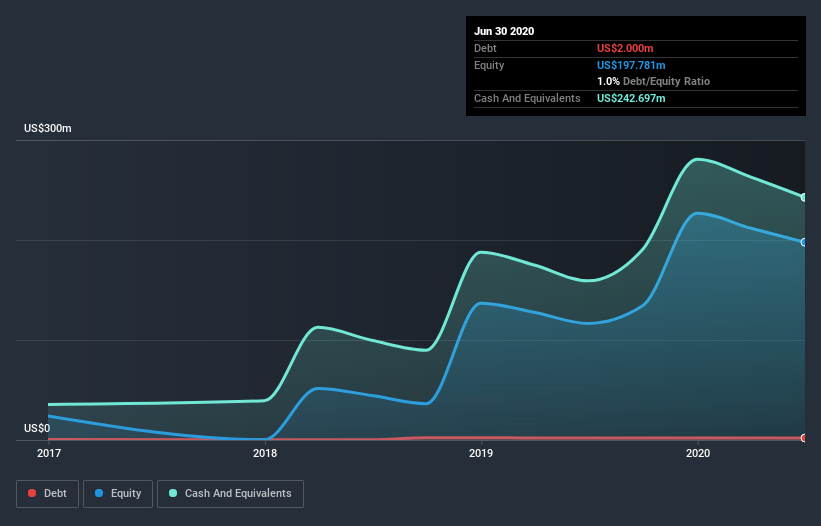Rock star Growth Puts Arvinas (NASDAQ:ARVN) In A Position To Use Debt

Legendary fund manager Li Lu (who Charlie Munger backed) once said, 'The biggest investment risk is not the volatility of prices, but whether you will suffer a permanent loss of capital.' It's only natural to consider a company's balance sheet when you examine how risky it is, since debt is often involved when a business collapses. We can see that Arvinas, Inc. (NASDAQ:ARVN) does use debt in its business. But the more important question is: how much risk is that debt creating?
When Is Debt A Problem?
Debt and other liabilities become risky for a business when it cannot easily fulfill those obligations, either with free cash flow or by raising capital at an attractive price. In the worst case scenario, a company can go bankrupt if it cannot pay its creditors. However, a more usual (but still expensive) situation is where a company must dilute shareholders at a cheap share price simply to get debt under control. By replacing dilution, though, debt can be an extremely good tool for businesses that need capital to invest in growth at high rates of return. When we examine debt levels, we first consider both cash and debt levels, together.
Check out our latest analysis for Arvinas
What Is Arvinas's Debt?
The chart below, which you can click on for greater detail, shows that Arvinas had US$2.00m in debt in June 2020; about the same as the year before. However, it does have US$242.7m in cash offsetting this, leading to net cash of US$240.7m.
A Look At Arvinas's Liabilities
We can see from the most recent balance sheet that Arvinas had liabilities of US$33.7m falling due within a year, and liabilities of US$31.1m due beyond that. Offsetting this, it had US$242.7m in cash and US$3.56m in receivables that were due within 12 months. So it can boast US$181.5m more liquid assets than total liabilities.
This excess liquidity suggests that Arvinas is taking a careful approach to debt. Given it has easily adequate short term liquidity, we don't think it will have any issues with its lenders. Succinctly put, Arvinas boasts net cash, so it's fair to say it does not have a heavy debt load! The balance sheet is clearly the area to focus on when you are analysing debt. But ultimately the future profitability of the business will decide if Arvinas can strengthen its balance sheet over time. So if you're focused on the future you can check out this free report showing analyst profit forecasts.
Over 12 months, Arvinas reported revenue of US$47m, which is a gain of 210%, although it did not report any earnings before interest and tax. That's virtually the hole-in-one of revenue growth!
So How Risky Is Arvinas?
Statistically speaking companies that lose money are riskier than those that make money. And we do note that Arvinas had an earnings before interest and tax (EBIT) loss, over the last year. Indeed, in that time it burnt through US$59m of cash and made a loss of US$86m. While this does make the company a bit risky, it's important to remember it has net cash of US$240.7m. That means it could keep spending at its current rate for more than two years. Importantly, Arvinas's revenue growth is hot to trot. While unprofitable companies can be risky, they can also grow hard and fast in those pre-profit years. When analysing debt levels, the balance sheet is the obvious place to start. However, not all investment risk resides within the balance sheet - far from it. Consider for instance, the ever-present spectre of investment risk. We've identified 4 warning signs with Arvinas (at least 1 which is a bit concerning) , and understanding them should be part of your investment process.
Of course, if you're the type of investor who prefers buying stocks without the burden of debt, then don't hesitate to discover our exclusive list of net cash growth stocks, today.
This article by Simply Wall St is general in nature. It does not constitute a recommendation to buy or sell any stock, and does not take account of your objectives, or your financial situation. We aim to bring you long-term focused analysis driven by fundamental data. Note that our analysis may not factor in the latest price-sensitive company announcements or qualitative material. Simply Wall St has no position in any stocks mentioned.
Have feedback on this article? Concerned about the content? Get in touch with us directly. Alternatively, email editorial-team@simplywallst.com.

 Yahoo Movies
Yahoo Movies 

